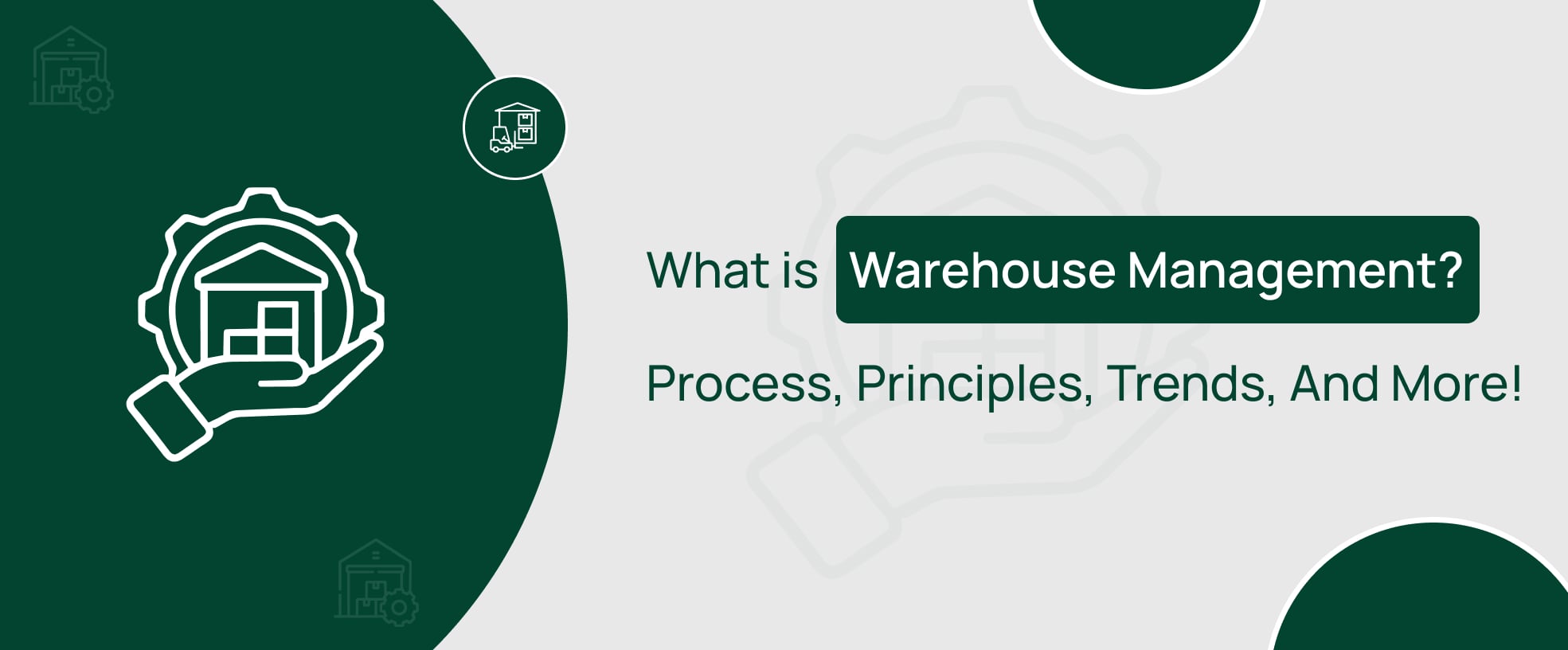What is Warehouse Management? Process, Principles, Trends, And More!

What is warehouse management? It involves accuracy and efficiency in every pick—just pack and be ready to ship! Here are all the basics of warehouse management that you need to know!
Warehouse management entails supervising, coordinating, and tracking daily operations within a warehouse. This encompasses managing inventory, receiving shipments, packing orders, and performing other tasks. These processes boost shipping efficiency and effectively maintain inventory levels. The aim is to improve operational efficiency and accuracy.
What is Warehouse Management And How Does It Work?
Let’s understand what warehouse management is, and grasp its functionality. Here’s how it works!
Primarily, warehouse management is the process of running the warehouse operations smoothly. It is about tracking the stocks, monitoring sales orders, plus their deliveries. This ensures inventory sufficiency, and the use of ABC analysis ensures the precision of stocks.
In short, it is a complex process of coordinating moving parts, inventory, orders, and people to ensure reduced costs and a streamlined process.
What is a Warehouse Management System?
Before proceeding, it is essential to understand what a warehouse management system is. This software helps companies monitor, manage, and optimize daily warehouse operations.
WMS manages everything right from when goods and materials enter the distribution center until they are dispatched.
Receiving Goods:
Packing:
Inventory Management:
Labor Management:
WMS systems manage, automate, and organize warehouse processes, from inbound receipts to deliveries. This leads to better efficiency and hassle-free logistic operations for handling a large volume of data.
Cutting down on errors and waste leads to productivity at its best. This is how warehouse management works.
Get To Know The Unknown:
Before moving on to the features and benefits of warehouse management system, let us first check out interesting and unknown facts about WMS.
- The Logistics Management report states that WMS is used in 85% of the warehouse operations. The constraints of space and the labor market have not affected its popularity. [1]
- Companies using WMS can achieve up to 20% reduction in operational costs and a 30% increase in inventory accuracy. [2]
- The value of the global warehouse automation market is estimated to be above 23 billion US dollars. It is growing at a CAGR of 15% and will reach 41 billion dollars in 2027 [3]
Understanding The Role of Warehouse Management:
So, what is a WMS? Simply put, it manages the storage movement, tracking the physical goods, fulfilling orders, maintaining inventory, etc.
What is The Process of Warehouse Management?
It plays a pivotal role. From receiving goods to storing them, picking & packing, and finally delivering them is warehouse management. Here is the step-by-step process to make you understand its key roles.
Step #1 – Inventory Reception and Tracking
The role of WMS begins as soon as the inventory arrives. It tracks what arrives and when it arrives and stores it quickly so that it can be retrieved when needed.
Step #2 – Picking and Packing
When an order arrives, it must be collected from its storage location. A WMS system generates a pick list for each picker to retrieve items efficiently. After that, packers secure the items in shipping containers.
Step #3 – Inventory Management
Inventory management is very crucial to efficiently running warehouse operations. It is the process that involves monitoring, tracking, and complete control of inventory. It aims to optimize the stock levels so the warehouses are never out of or under-stock.
Step #4 – Best Warehouse Space Optimization
According to a survey report, only 85% of warehouse space is used wisely. This means that there is still room for optimal use. An effective warehouse management system maintains the movement of goods in the storage space, and equipment maximizes space utilization.
Besides that, WMS provides customers with completed order tracking details. The system tracks the inventory’s exact location and monitors its overall health. This ensures that orders are filled quickly and that their fulfillment is precise, eventually leading to quality control and a better customer satisfaction rate.
What Are The Principles of Warehouse Management?
Warehouse management involves optimizing the efficiency of the supply chain and reducing resource waste, which leads to cost savings.
Maintaining the Optimum Stock Levels:
Warehouses find it challenging to maintain just the right stock level. Holding surplus stocks is a financial burden, and a shortage of stock leads to unfulfilled demands. If done properly, it ensures that stocks are well-managed and monitored.
Sales Orders Get Processed Quickly:
Swift and accurate sales order processing does not just happen at the point of sale. It begins when the sales orders are lodged. Proper warehouse management makes accurate sales processing possible.
Movement and Storage of Materials is Controlled:
When stock storage and movement are controlled correctly, accurate detailing of the stocks and their fulfillment is possible. This is made easy with warehouse management, and you can also have a huge profit margin.
Process the Transactions Easily:
All the transactions associated with the warehouse are processed efficiently for a smooth-running supply chain. This eases the process of shipping, receiving, picking, packing, and more.
-> In addition, linking warehouse management to sales order processing improves operational efficiency, better processing of orders, and reduces wastage.
Key Benefits of Warehouse Management System
WMS is the heart and soul of supply chain management. It has several benefits that make it a must-have software. Mentioned here are a few:
#1 – Improved Inventory Accuracy:
Reduces any discrepancies in the stock, ensuring neither a shortage nor an oversupply. This dramatically reduces costs and ensures maximal resource utilization.
#2 – Enhanced Customer Satisfaction Rate:
Faster processing of orders and timely delivery ensure that the customers are satisfied. Happy customers lead to a flourishing business.
#3 – Reduced Operational Costs:
When the manual tasks are fully automated, there is a reduced risk of errors and better efficiency and accuracy.
#4 – Valuable Data Insights:
Better decision-making is achievable due to WMS software’s valuable data insights, analytics, and reporting capabilities.
In short, you can optimize inventory, reduce operational costs, improve efficiency and productivity, and more with WMS. Want to know more about the benefits of a warehouse management system ? Explore them here!
Essential Features of Warehouse Management System
In short, WMS can help you optimize inventory, reduce operational costs, improve efficiency and productivity, and more.
Inventory Management:
It is the process of ordering, storing, managing spaces, etc. It is an essential feature of the WMS. It includes tracking the movement of supplies and products. This, in turn, ensures that the sales and production process is hassle-free and that stocks are replenished on time.
Labor Management:
Labor management is another essential feature of WMS. It enables businesses to track, optimize, and manage their workforce to improve efficiency and increase productivity.
Reporting and Analytics:
It enables users to access real-time data and generate reports on warehouse operations. Users can review and evaluate the latest trends and key performance indicators to make informed decisions and optimize the warehouse’s inventory.
Picking and Packing:
The software generates picking lists that guide the warehouse workers through the most efficient routes. This reduces picking time and errors.
Want to delve into all the features in detail? This is a valuable resource! Check out the features of the warehouse management system to gain a deep understanding.
Tips And Fulfillment Strategies For Improving Your Warehouse Management
Do you want to improve and make the most of your warehouse management? Here are some quick tips and fulfillment strategies.
Tips for Efficient Warehouse Management
Fulfillment Strategies for Efficient Warehouse Management
Top 5 Warehouse Management Software Systems
Want to choose only the best? Here are the top 5 WMS systems that are top-rated.
#1 – CommuteLogix
CommuteLogix is one of the best top-tier software solutions for optimizing your warehouse. It has helped several businesses with the best WMS for over a decade. It features AI-powered automation and seamless ERP integration, which maximize efficiency and save costs.
Get real-time visibility into different types of warehouse operations. Automation also streamlines warehouse operations, and a unified supply chain is provided when demand slotting, automation, and labor slotting are combined.
#2 – Manhattan WMS
Manhattan WMS is your one-stop software solution for warehouse management. It is a well-known name for providing flexible and scalable solutions. It supports warehouse functions like labor management, order processing, and inventory tracking.
#3 – SAP EWM
SAP suite is a leading WMS. The software provides many comprehensive functionalities. From managing the aspects of the warehouse to receiving goods, storing inventory, picking plus packing orders, and more. Efficient and optimized operations are possible with SAP EWM.
#4 – Blue Yonder WMS
This AI-driven WMS increases supply chain visibility, improves warehouse workflows, and helps users make data-driven decisions. It optimizes end-to-end warehouse operations. This software service provider has over a decade of experience in customer-centric WMS development.
#5 – Oracle WMS Cloud
This is another industry-leading global warehouse software that ensures seamless production and distribution of goods. This cloud-based WMS supports worldwide logistics operations. It is mainly known for its real-time inventory tracking, order processing, and automation.
To explore more Warehouse Management System options that fit your needs, read the article “Best Warehouse Management System” for all the insights.
Why is CommuteLogix a One-Stop Solution For Warehouse Management?
There is not one but several reasons to choose CommuteLogix. This WMS software provides cutting-edge automation and AI-driven insights. It is easy to integrate and use.
How about transforming your warehouse management and taking its productivity plus profitability to the next level?
Get CommuteLogix Today!Future Trends, Challenges & Solutions
Warehouse Management would be transformed completely in the coming years. With the growth of technology, Warehouse management will undergo a drastic change. There will be increased automation via robotics. With AI-driven predictive analysis, improved accuracy and better real-time tracking will be possible.
Robotics and IoT-enabled tracking can address common warehouse management challenges such as space utilization and supply chain disruptions.
Future Trends in Warehouse Management
Here are some expected future trends in warehouse management that will make the process more efficient.
AI and Machine Learning:
Increased predictive analytics and automation will improve efficiency and precision, and robotic trends will ease warehouse operations.
IoT-Enabled Tracking:
IoT, or the Internet of Things driven tracking, will better track the location, condition, and performance of assets.
Sustainable Warehousing:
Eco-friendly practices by the WMS system will lead to a sustainable and eco-friendly WMS system.
Get to know the warehouse technologies: system, equipment, and software that would lead to far better efficiency in shipping, storage, picking and packing, etc. Check it out here!
What Are The Common Challenges Faced in Warehouse Management?
Here are a few commonly faced challenges in warehouse management.
The article provides a better and more detailed insight into the challenges in warehouse management.
Basic Solutions For Challenges in Warehouse Management
No problem exists without a solution, which applies to the challenges. Here are some solutions to those challenges.
Wrapping Up:
Warehouse management is the need of the hour. It ensures a smooth-running inventory and manages labor, supply, plus cost. By leveraging this cutting-edge technology, businesses can streamline operations, increase efficiency accuracy, and improve customer satisfaction rates.
Now that you know what WMS is, how it works, and its features plus benefits, be ready to integrate it for hassle-free warehouse management.
Key Takeaways:
Got questions? We’re here to listen!
Doubts and confusion can blur your vision and hamper your decision-making. If you have doubts, let us know, and we will clarify them.
1. What is the main function of warehouse management?
Warehouse management has several functions. It is more like a necessity for warehouse operations. The main functions are maintaining and tracking inventory, processing orders, and shipping.
2. What are the four types of warehouse management systems?
Four types of WMS are Supply chain modules, ERP-integrated WMS, standalone WMS, and Cloud-based WMS.
3. What are the main tasks of a warehouse manager?
A warehouse manager does several tasks like controlling inventory, fulfilling orders, managing the workforce plus labor force, and optimizing the entire process.
4. What is the cost of a warehouse management system?
The costs of WMS software vary and depend on several factors, such as its features, the customization you need, and scalability. Compare software rates, features, and benefits to get the best value.
5. What is the difference between warehouse management and inventory management?
Warehouse management is a broad term that encompasses several tasks, including inventory management, picking and packing, labor management, and more. Conversely, inventory management is solely concerned with stock levels.
Let us Know Your Warehouse Pains! We Are A Click Away!
iCommuneTech offers the ideal software solution for any challenges you face with your warehouse workflows. Transform your warehouse operations completely and unlock the hidden potential and benefits of a warehouse management system!
Schedule a call with us today!

